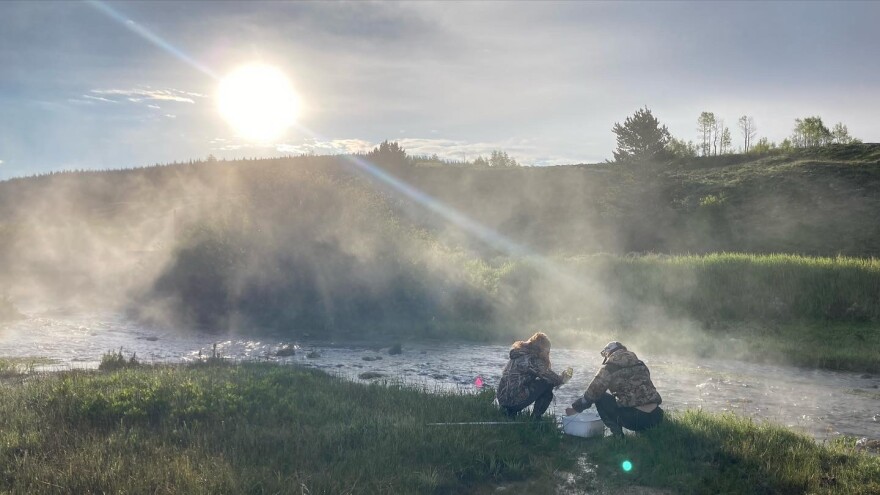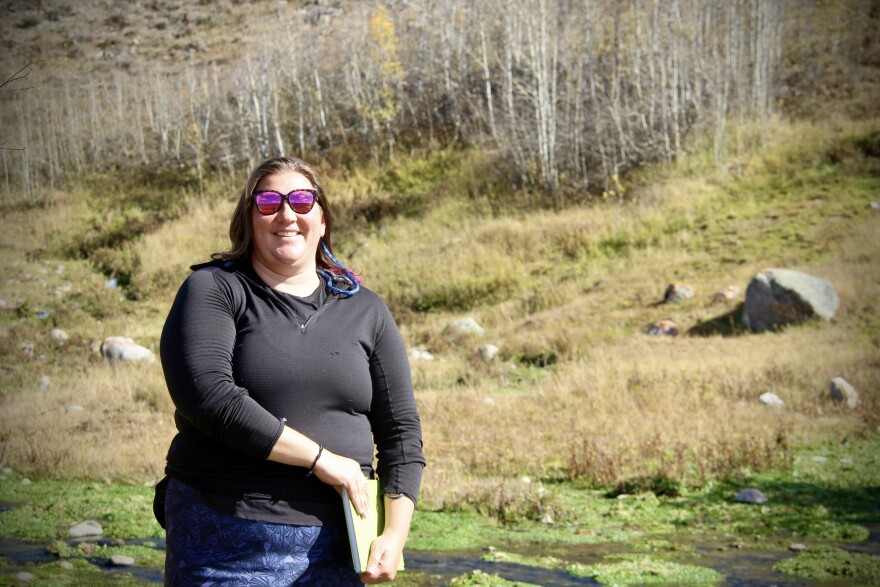On a recent crisp fall day, Kate Olsen drove down a bumpy National Forest Service road in the Upper Green. Olsen is in her 30s, and she was wearing a blue skirt with leggings so she can hike around. She had some streaks of pink dye in her hair.
“I just got my haircut today, the pink is usually more hidden,” she said.
But the main thing about Olsen is she’s a fish biologist for the U.S. Forest Service and loves and knows all things fish. Part of her job is managing a fish that is only found in one place in the world: in a 1,000-foot stretch of stream in the Upper Green. The Kendall Warm Springs dace is a tiny fish that’s been listed as endangered for 50 years.
“Which, so many people don't even know, people who live in this county don't even know, the species exists,” Olsen said.
Prior to getting this job seven years ago, Olsen also didn’t know about the rare fish. Now, she manages it, making her one of the few people in the world qualified to talk about this fish. The future of the species largely falls on her shoulders.
“The balance is always like, 'Am I having a panic attack?'” Olsen said half-joking, half-seriously.
We drove through an open sagebrush valley. The Green River carved through the landscape and the Wind River Range towered over.

“So we just crossed this cattle guard,” Olsen said loudly over the distinct rumbling sound. “And there's a fence around the entire area – it's called a Kendall Warm Springs Special Interest Area.”
It surrounds a thousand feet of shallow stream that’s always about 85 degrees – it’s fed by a geothermal hot spring – and it’s home to the endangered fish.
We parked off a small bridge that goes over the warm springs. But, you wouldn’t really know an endangered species lives there.
“It's a little cryptic. And we go back and forth on wanting to draw attention to a really unique and cool species and wanting to protect it,” Olsen said.

Basically, they don’t want people wading in the water, disrupting or harming the fish.
We walked through some sagebrush to get to a 15-foot waterfall that separates the warm springs from the river.
“It looks like Hawaii or something. It feels so out of place, like, the very bright green vegetation and the almost lava-looking rock,” Olsen said over the rushing sound of water.
The waterfall formed after glaciers receded about 15,000 years ago.
“And when it was first starting, the waterfall was six inches high and then it was 12 inches high,” she said.
At that point, the fish was actually just the more common speckled dace – a fish that’s thriving to this day and is found from Canada to Mexico. But as the waterfall got taller…
“The fish could no longer move between the warm spring and river once the falls got high enough,” Olsen said. “And at that point, they then started to evolve into their own subspecies of speckled dace.”
Essentially, the fish got trapped and evolved into the Kendall Warm Springs dace – living upstream of the waterfall, separate from all the foot-long trout just below in the river.

“There’s like 10 fish over a foot-long in there,” Olsen pointed out as she peered over the river. “Every day I go out in the field and I think, 'Why don't you bring your fly rod out for your lunch break?' Sorry, you were asking a question and I obviously got distracted by fish.”
Olsen’s passion and love for not just the dace, but fish in general, was strong – and contagious.
We walked upstream along the warm springs, hoping to spot the rare fish we came to see.
“You see that light colored, sandy and pebble bottom? It just had five or six of them darting around,” Olsen said. “There was one that was an adult fish maxing out in that one and a half to two inch neighborhood.”
The warm springs dace are olive colored, and the youngins are teeny tiny.
“I refer to them as fingernail clippings, because they’re about that size and they’re transparent,” she said.

She added that the population has declined for at least 20 years. We don’t really know exactly why, but, a couple years ago, she and another fish biologist were looking at the warm springs and saw something green.
“He said, ‘I think this is watercress?’ And we were both like, ‘Is that not native?’” she remembered.
Watercress is an invasive species. It looks like microgreens growing across the stream, forcing the water to flow faster and through smaller channels. That could be hurting the fish.
“We did our best to remove 100 percent of the watercress from the system last year,” Olsen said. “So what you're looking at here is an answer to a question about how quickly it recolonizes.”

The sprawling green plant was everywhere. Olsen said the next big project is figuring out the best way to remove it.
As we were heading back to the truck, Olson wanted to make sure she mentioned all of her favorite things about the Warm Springs dace. She leafed through her green notebook, neatly organized with tabs.
“I wanted to make sure I used the word endemic. I think I did. It's a good word for people to know,” she said. “Endemic means something lives here and nowhere else. And that is the part for dace that just feels like this is just such an exceptional species to work with and manage.”

And with that, we bid the Kendall Warm Springs dace goodbye and drove back out toward Pinedale. Now, one might question – surely a few fish must swim off that waterfall and into the river below? But, Olsen has already considered this.
“My guess is they get ‘chomp, chomp, chomped,’” she said with a smile.







